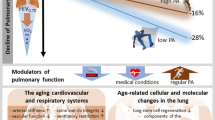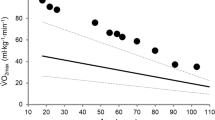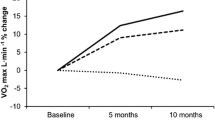Abstract
Because of the influence of cardiorespiratory fitness on functional independence, quality of life, and cardiovascular disease and all-cause mortality, tremendous interest has been directed towards describing the age-related change in maximal oxygen consumption (V̇O2max). Current evidence supports a 10% per decade decline in V̇O2max in men and women regardless of activity level. High-intensity exercise may reduce this loss by up to 50% in young and middle-aged men, but not older men, if maintained long term. Middle-aged and older women do not appear to be able to reduce loss rates in V̇O2max to less than 10% per decade, which may be related to estrogen status. However, maintaining high-intensity training seems limited to approximately one decade at best and to a select few individuals. While the factors limiting the ability to maintain high-intensity training are not completely known, aging most likely plays a role as studies have demonstrated that training maintenance becomes more difficult with advancing age. Age-related loss of V̇O2max seems to occur in a non-linear fashion in association with declines in physical activity. In sedentary individuals, this non-linear decline generally occurs during the twenties and thirties whereas athletic individuals demonstrate a non-linear decline upon decreasing or ceasing training. Non-linear loss rates are also demonstrated in individuals over the age of 70 years. The decline in V̇O2max seems to be due to both central and peripheral adaptations, primarily reductions in maximal heart rate (HRmax) and lean body mass (LBM). Exercise training does not influence declines in HRmax, while LBM can be maintained to some degree by exercise. Recommendations for exercise training should include aerobic activities utilising guidelines established by the American College of Sports Medicine for improving CV fitness and health, as well as strength training activities for enhancing LBM.




Similar content being viewed by others
References
Pugh KG, Wei JY. Clinical implications of physiological changes in the aging heart. Drags Aging 2001; 18(4): 263–76
Barnard RJ, Grimditch GK, Wilmore JH. Physiological characteristics of sprint and endurance masters runners. Med Sci Sports Exerc 1979; 11(2): 167–71
Durstine JL, Moore GE, editors. ACSM’s exercise management for persons with chronic diseases and disabilities. Champaign (IL): Human Kinetics, 2003
Shephard RJ, Allen C, Benade AVS, et al. The maximal oxygen intake: an international reference standard of cardiorespiratory fitness. Bull World Health Organ 1968; 38: 757–64
Paffenbarger RS, Wing AL, Hyde RT. Physical activity as an index of heart attack risk in college alumni. Am J Epidemiol 1978; 108: 161–75
Blair SN, Kampert JB, Kohl III HW, et al. Influences of cardiorespiratory fitness and other precursors on cardiovascular disease and all-cause mortality in men and women. JAMA 1996; 276: 205–10
Wei M, Kampert JB, Barlow CE, et al. Relationship between low cardiorespiratory fitness and mortality in normal-weight, overweight, and obese men. JAMA 1999; 282: 1547–53
Myers J, Prakash M, Froelicher V, et al. Exercise capacity and mortality among men referred for exercise testing. N Engl J Med 2002; 346: 793–801
Robinson S. Experimental studies of physical fitness in relation to age. Arbeitsphysiologie 1938; 10: 251–323
Bortz IV WM, Bortz II WM. How fast do we age?: exercise performance over time as a biomarker. J Gerontol A Biol Sci Med Sci 1996; 51A(5): M223–5
Sehl ME, Yates FE. Kinetics of human aging: I. Rates of senescence between ages 30 and 70 years in healthy people. J Gerontol A Biol Sci Med Sci 2001; 56A(5): B198–208
Heath GW, Hagberg JM, Ehsani AA, et al. A physiological comparison of young and older endurance athletes. J Appl Physiol 1981; 51: 634–40
Hagberg JM, Allen WK, Seals DR, et al. A hemodynamic comparison of young and older endurance athletes during exercise. J Appl Physiol 1985; 58: 2041–6
Astrand I. Aerobic capacity in men and women with specific reference to age. Acta Physiol Scand Suppl 1960; 49: 1–92
Shephard RJ. World standards of cardiorespiratory performance. Arch Environ Health 1966 Nov; 13: 664–70
Drinkwater BL, Horvath SM, Wells CL. Aerobic power in females, ages 10 to 68. J Gerontol A Biol Sci Med Sci 1975; 30: 385–94
Hossack KF, Bruce RA. Maximal cardiac function in sedentary normal men and women: comparison of age-related changes. J Appl Physiol 1982; 53: 799–804
Vogel JA, Patton JF, Mello RP, et al. An analysis of aerobic capacity in a large United States population. J Appl Physiol 1986; 60: 494–500
Inbar O, Oren A, Scheinowitz M, et al. Normal cardiopulmonary responses during incremental exercise in 20- to 70-yr-old men. Med Sci Sports Exerc 1994; 26(5): 538–46
Toth MJ, Gardner AW, Ades PA, et al. Contribution of body composition and physical activity to age-related decline in peak V̇O2 in men and women. J Appl Physiol 1994; 77: 647–52
Jackson AS, Beard EF, Wier LT, et al. Changes in aerobic power of men, ages 25–70 yr. Med Sci Sports Exerc 1995; 27(1): 113–20
Jackson AS, Wier LT, Ayers GW, et al. Changes in aerobic power of women, ages 20–64 yr. Med Sci Sports Exerc 1996; 28(7): 884–91
Cunningham DA, Pateson DH, Koval JJ, et al. A model of oxygen transport capacity changes for independently living older men and women. Can J Appl Physiol 1997; 22(5): 439–53
Schiller BC, Casas YG, Desouza CA, et al. Maximal aerobic capacity across age in healthy Hispanic and Caucasian women. J Appl Physiol 2001; 91: 1048–54
Pollock ML, Miller HS, Wilmore J. Physiological characteristics of champion American track athletes 40 to 75 years of age. J Gerontol A Biol Sci Med Sci 1974; 29(6): 645–9
Fuchi T, Iwaoa K, Higuchi M, et al. Cardiovascular changes associated with decreased aerobic capacity and aging in longdistance runners. Eur J Appl Physiol 1989; 58: 884–9
Tanaka H, DeSouza CA, Jones PP, et al. Greater rate of decline in maximal aerobic capacity with age in physically active vs sedentary healthy women. J Appl Physiol 1997; 83: 1947–53
Rosen MJ, Sorkin JD, Goldberg AP, et al. Predictors of age-associated decline in maximal aerobic capacity: a comparison of four statistical models. J Appl Physiol 1998; 84: 2163–70
Wiebe CG, Gledhill N, Jamnik VK, et al. Exercise cardiac function in young through elderly endurance trained women. Med Sci Sports Exerc 1999; 31(5): 684–91
Wiswell RA, Hawkins SA, Jaque SV, et al. Relationship between physiological loss, performance decrement, and age in master athletes. J Gerontol A Biol Sci Med Sci 2001; 56A(7): M1–9
Pimental AE, Gentile CL, Tanaka H, et al. Greater rate of decline in maximal aerobic capacity with age in endurance-trained than in sedentary men. J Appl Physiol 2003; 94: 2406–13
Meredith CN, Zackin MJ, Frontera WR, et al. Body composition and aerobic capacity in young and middle-aged endurance-trained men. Med Sci Sports Exerc 1987; 19(6): 557–63
Pollock ML, Mengelkoch LJ, Graves JE, et al. Twenty-year follow-up of aerobic power and body composition of older track athletes. J Appl Physiol 1997; 82: 1508–16
Dehn MM, Bruce RA. Longitudinal variations in maximal oxygen intake with age and activity. J Appl Physiol 1972; 33: 805–7
Plowman SA, Drinkwater BL, Horvath SM. Age and aerobic power in women: a longitudinal study. J Gerontol 1979; 34(4): 512–20
Astrand I, Astrand P-O, Hallback I, et al. Reduction in maximal oxygen uptake with age. J Appl Physiol 1973; 35: 649–54
Kasch F, Wallace JP. Physiological variables during 10 years of endurance exercise. Med Sci Sports Exerc 1976; 8: 5–8
Robinson S, Dill DB, Tzankoff SP, et al. Longitudinal studies of aging in 37 men. J Appl Physiol 1975; 38: 263–7
Robinson S, Dill DB, Robinson BD, et al. Physiological aging of champion runners. J Appl Physiol 1976; 41: 46–51
Pollock ML, Foster C, Knapp D, et al. Effect of age and training on aerobic capacity and body composition of master athletes. J Appl Physiol 1987; 62: 725–31
Rogers MA, Hagberg JM, Martin III WH, et al. Decline in V̇O2max with aging in master athletes and sedentary men. J Appl Physiol 1990; 68: 2195–9
Marti B, Howald H. Long-term effects of physical training on aerobic capacity: controlled study of former elite athletes. J Appl Physiol 1990; 69: 1451–9
Kasch FW, Boyer JL, Van Camp SP, et al. The effect of physical activity and inactivity on aerobic power in older men (a longitudinal study). Phys Sportsmed 1990; 18(4): 73–83
Kasch FW, Boyer JL, Van Camp S, et al. Cardiovascular changes with age and exercise: a 28-year longitudinal study. Scand J Med Sci Sports 1995; 5: 147–51
Trappe SW, Costill DL, Vukovich MD, et al. Aging among elite distance runners: a 22-yr longitudinal study. J Appl Physiol 1996; 80: 285–90
Hagerman FC, Fielding RA, Fiatarone MA, et al. A 20-year longitudinal study of Olympic oarsmen. Med Sci Sports Exerc 1996; 28: 1150–6
Kasch FW, Boyer JL, Schmidt PK, et al. Ageing of the cardiovascular system during 33 years of aerobic exercise. Age Ageing 1999; 28: 531–6
Katzel LI, Sorkin JD, Fleg JL. A comparison of longitudinal changes in aerobic fitness in older endurance athletes and sedentary men. J Am Geriatr Soc 2001; 49: 1657–64
Hawkins SA, Marcell TJ, Jaque SV, et al. A longitudinal assessment of change in V̇O2max and maximal heart rate in master athletes. Med Sci Sports Exerc 2001; 33(10): 1744–50
Eskurza I, Donato AJ, Moreau KL, et al. Changes in maximal aerobic capacity with age in endurance-trained women: 7-year follow-up. J Appl Physiol 2002; 92: 2303–8
Buskirk ER, Hodgson JL. Age and aerobic power: the rate of change in men and women. Fed Proc 1987; 46: 1824–9
Hagberg JM. Effect of training on the decline of V̇O2max with aging. Fed Proc 1987; 46: 1830–3
Rivera AM, Pels III AE, Sady SP, et al. Physiological factors associated with the lower maximal oxygen consumption of master runners. J Appl Physiol 1989; 66: 949–54
Fleg JL, Lakatta EG. Role of muscle mass in the age-associated reduction in V̇O2max. J Appl Physiol 1988; 65: 1147–51
Proctor DN, Joyner MJ. Skeletal muscle mass and the reduction of V̇O2max in trained older subjects. J Appl Physiol 1997; 82(5): 1411–5
Makrides L, Heigenhauser GJ, Jones NL. High-intensity endurance training in 20- to 30- and 60- to 70-yr-old healthy men. J Appl Physiol 1990; 69: 1792–8
Kohrt WM, Malley MT, Coggan AR, et al. Effects of gender, age, and fitness level on response of V̇O2max to training in 60–71 yr olds. J Appl Physiol 1991; 71: 2004–11
Seals D, Hagberg J, Hurley B, et al. Effects of endurance training on glucose tolerance and plasma lipid levels in older men and women. JAMA 1984; 252: 645–9
Hagberg J, Montain S, Martin W, et al. Effect of exercise training on 60 to 69 year old persons with essential hypertension. Am J Cardiol 1989; 64: 348–53
Kelley GA, Kelley KS. Aerobic exercise and resting blood pressure in older adults: a meta-analytic review of randomized controlled trials. J Gerontol A Biol Sci Med Sci 2001; 56A(5): M298–303
Balady GJ. Survival of the fittest: more evidence. N Engl J Med 2002; 346(11): 852–3
American College of Sports Medicine. Position stand: exercise and physical activity for older adults. Med Sci Sports Exerc 1998; 30(6): 992–1008
Pate RR, Pratt M, Blair SN, et al. Physical activity and public health: a recommendation from the Centers for Disease Control and Prevention and the American College of Sports Medicine. JAMA 1995; 273: 402–7
Frontera W, Meredith C, O’Reilly K, et al. Strength conditioning in older men: skeletal muscle hypertrophy and improved function. J Appl Physiol 1988; 64: 1038–44
Sipila S, Suominen H. Effects of strength and endurance training on thigh and leg muscle mass and composition in elderly women. J Appl Physiol 1995; 78: 334–40
Klitgaard H, Mantoni M, Schiaffino S, et al. Function, morphology and protein expression of ageing skeletal muscle: a cross-sectional study of elderly men with different training backgrounds. Acta Physiol Scand 1990; 140: 41–54
Sipila S, Viitasalo J, Era P, et al. Muscle strength in male athletes aged 70–81 years and a population sample. Eur J Appl Physiol 1991; 63: 399–403
Alway SE, Coggan AR, Sproul MS, et al. Muscle torque in young and older untrained and endurance-trained men. J Gerontol A Biol Sci Med Sci 1996; 51A(3): B195–201
Hyatt G. Strength training for the aging adult. Activities Adaptation Aging 1996; 20(3): 27–36
Acknowledgements
No sources of funding were used to assist in the preparation of this manuscript. The authors have no conflicts of interest that are directly relevant to the content of this manuscript.
Author information
Authors and Affiliations
Corresponding author
Rights and permissions
About this article
Cite this article
Hawkins, S.A., Wiswell, R.A. Rate and Mechanism of Maximal Oxygen Consumption Decline with Aging. Sports Med 33, 877–888 (2003). https://doi.org/10.2165/00007256-200333120-00002
Published:
Issue Date:
DOI: https://doi.org/10.2165/00007256-200333120-00002




